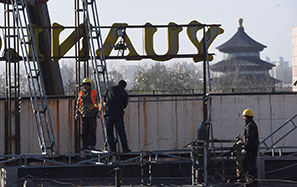Lessons from2004 tsunami fade with time
Experts warn of dangers of 'disaster amnesia' as 10th anniversary of catastrophe approaches
Ten years after the deadliest tsunami on record wrought destruction across the Indian Ocean, creeping complacency is undermining a high-tech warning system designed to prevent another disaster of such shocking magnitude.
On the morning of Dec 26, 2004, a 9.3-magnitude earthquake off Indonesia's western coast generated a series of massive waves that killed more than 220,000 people across 14 countries from Indonesia to Somalia.
Among the victims were thousands of foreign tourists, the majority enjoying the Christmas period in Thailand. Footage of the tsunami spread the horrors of the disaster to homes around the world.
There were no warning systems in place and not enough time for many people to find higher ground as the towering wave hit coastal areas. Others simply stared in awe and curiosity as the sea at first retreated before rushing back as a wall of churning water.
As the 10th anniversary of the tsunami approaches, experts warn that the memory of that fateful day is fading, taking with it the appetite for disaster preparedness.
"When you forget, you don't prepare," said Margareta Wahlstroem, head of the UN Office for Disaster Risk Reduction, who played a leading role in organizing the UN recovery efforts a decade ago.
"Disaster amnesia" threatens to lower defenses, Wahlstroem said.
"You relax, and that's dangerous. ... One of the big challenges in reducing disaster risk is to keep alive this understanding."
It took about 20 minutes after the quake for the first waves - some more than 35 meters high - to hit the coast of Aceh, where the vast majority of Indonesia's 170,000 victims died.
'Flying blind'
But it was about two hours later that the tsunami cut into Thailand as well as India and Sri Lanka.
"We were flying blind, without any kind of sensors in the Indian Ocean," Charles McCreery, director of the US government's Pacific Tsunami Warning Center, told a recent conference in Jakarta.
After "100 years of calm", there have been six quakes of 7.9 or above in the Indian Ocean since 2004 in a period of "heightened activity", McCreery said.
To prevent losses again, the Indian Ocean Tsunami Warning System - spanning the ocean and monitored by hubs in Indonesia, Australia and India - began operations in 2011.
This network of tidal gauges, deep ocean buoys and seismic monitors is used to warn other countries in the region of impending tsunamis.
Twenty-four countries around the Indian Ocean have also set up their own national warning centers.
Thailand - which saw 5,395 people, half of them foreign tourists, killed by the disaster - runs a 24-hour monitoring hub linked by satellite to 129 warning towers in the six tsunami-hit provinces alone.
A giant wave would trigger sirens and announcements in several languages through the towers, and send alerts via SMS to a network of officials in order to begin evacuations.
But on Thailand's Patong beach, in the tourist haven of Phuket, the paint is peeling off the orange warning tower that looms over hundreds of sunbathing holidaymakers.
And on Khao Lak, a nearby coastal resort area flattened by the tsunami, the signs urging people to run to higher ground have faded.
Yet population density has continued to rise along coastal areas as developers build in lucrative but high-risk shorefront areas.
The early warning systems are a big step in the right direction but are not enough on their own, said Professor Kerry Sieh of Nanyang Technological University in Singapore.
"It has to come with education and adequate infrastructure," he said, pointing to the importance of measures such as planning wider roads for evacuation.
|
Kusol Wetchakul offers prayers for his sister who died in the tsunami in Khao Lak, Thailand. Ten years later, authorities fear complacency is undermining a high-tech warning system. David Longstreath / Associated Press |



















